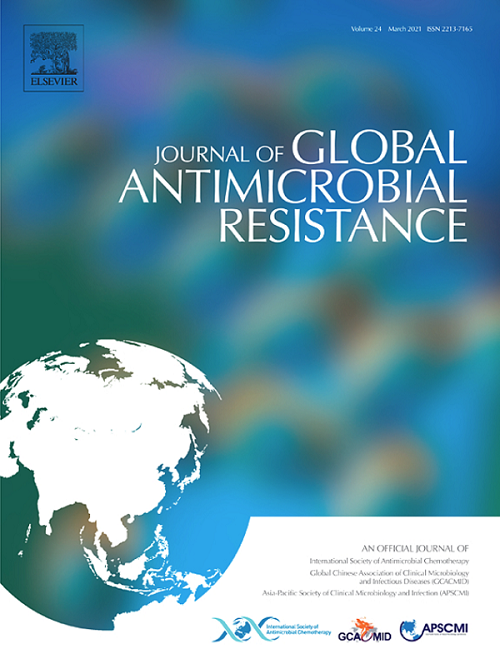探讨住院患者粪肠球菌和粪肠球菌分离株中CRISPR-Cas系统的流行情况及其与抗生素耐药基因和毒力因子的关系。
IF 3.2
3区 医学
Q2 INFECTIOUS DISEASES
引用次数: 0
摘要
目的:粪肠球菌和屎肠球菌是革兰氏阳性条件致病菌,是全世界医院感染的主要原因之一。本研究调查了CRISPR-Cas系统在伊朗德黑兰收集的临床分离的粪肠杆菌和粪肠杆菌中调节抗菌素耐药性和毒力因子的流行程度和作用。方法:于2023年1 - 4月在伊朗德黑兰市各医院收集尿路感染( = 55)、血液感染( = 12)和伤口感染( = 8)的成人患者临床分离的粪肠球菌和粪肠球菌75株。采用常规细菌学试验和PCR分离鉴定肠球菌菌种。评估表型抗生素和基因型耐药性。采用PCR技术筛选CRISPR-Cas重复间隔序列,统计分析CRISPR-Cas系统与抗生素耐药和毒力基因的关系。进行系统发育、结构和保守性分析,评估crispr1 - cascsn1和crispr3 - cascsn1基因的保守程度,鉴定潜在突变,并评估其对Cas9蛋白功能的可能影响。结果:86.6%的分离株携带CRISPR-Cas重复间隔序列,粪肠杆菌的感染率明显高于粪肠杆菌(100% vs. 66.6%, p = 0.0001)。分别在76%、82.6%和64%的分离株中发现了CRISPR1-Cas、CRISPR2和CRISPR3-Cas位点。值得注意的是,与多重耐药(MDR)分离株(68%,p = 0.0001)相比,广泛耐药(XDR)分离株(32%)中CRISPR-Cas系统的流行率显著降低。对crispr1 - cascsn1和crispr3 - cascsn1基因的保守分析揭示了可能与功能活性相关的保守区域。此外,CRISPR-Cas重复间隔序列与特定的抗微生物药物耐药性表型和基因型以及毒力因子相关。结论:这些发现提示CRISPR-Cas系统可能影响临床分离肠球菌的耐药性和毒力谱,可能影响其致病性和适应性。本文章由计算机程序翻译,如有差异,请以英文原文为准。
Investigating the prevalence of CRISPR-Cas system and their association with antibiotic resistance genes and virulence factors in Enterococcus faecalis and Enterococcus faecium strains isolated from hospitalized patients
Objectives
Enterococcus faecalis and Enterococcus faecium are Gram-positive opportunistic pathogens that rank among the leading causes of nosocomial infections worldwide. This study investigates the prevalence and role of CRISPR-Cas systems in modulating antimicrobial resistance and virulence factors in clinical isolates of E. faecalis and E. faecium collected from patients in Tehran, Iran.
Methods
A total of 75 clinical isolates of E. faecalis and E. faecium were collected from various hospitals in Tehran, Iran, between January and April 2023, from adult patients with urinary tract infections (n = 55), blood infections (n = 12), and wound infections (n = 8). Conventional bacteriology tests and PCR were used to isolate and identify Enterococcus species. Phenotypic antibiotic and genotypic resistance were assessed. CRISPR-Cas repeat-spacer array were screened using PCR, and the relationship between CRISPR-Cas systems and antibiotic resistance and virulence genes was statistically analyzed. Phylogenetic, structural, and conservation analyses were performed to assess the degree of conservation in CRISPR1-Cas csn1 and CRISPR3-Cas csn1 genes, identify potential mutations, and evaluate their possible impact on Cas9 protein function.
Results
86.6% of the isolates harbored CRISPR-Cas repeat-spacer array, with a significantly higher prevalence in E. faecalis than in E. faecium (100% vs. 66.6%, P = 0.0001). CRISPR1-Cas, CRISPR2, and CRISPR3-Cas loci were identified in 76%, 82.6%, and 64% of isolates, respectively. Notably, the prevalence of CRISPR-Cas systems was significantly reduced in extensively drug-resistant (XDR) isolates (32%) compared to multidrug-resistant (MDR) isolates (68%, P = 0.0001). Conservation analyses of CRISPR1-Cas csn1 and CRISPR3-Cas csn1 genes revealed conserved regions potentially linked to functional activity. Furthermore, CRISPR-Cas repeat-spacer array were correlated with specific antimicrobial resistance phenotypes and genotypes, as well as with virulence factors.
Conclusions
These findings suggest that CRISPR-Cas systems may influence the resistance and virulence profiles of clinical Enterococcus isolates, potentially impacting their pathogenicity and adaptability.
求助全文
通过发布文献求助,成功后即可免费获取论文全文。
去求助
来源期刊

Journal of global antimicrobial resistance
INFECTIOUS DISEASES-PHARMACOLOGY & PHARMACY
CiteScore
8.70
自引率
2.20%
发文量
285
审稿时长
34 weeks
期刊介绍:
The Journal of Global Antimicrobial Resistance (JGAR) is a quarterly online journal run by an international Editorial Board that focuses on the global spread of antibiotic-resistant microbes.
JGAR is a dedicated journal for all professionals working in research, health care, the environment and animal infection control, aiming to track the resistance threat worldwide and provides a single voice devoted to antimicrobial resistance (AMR).
Featuring peer-reviewed and up to date research articles, reviews, short notes and hot topics JGAR covers the key topics related to antibacterial, antiviral, antifungal and antiparasitic resistance.
 求助内容:
求助内容: 应助结果提醒方式:
应助结果提醒方式:


